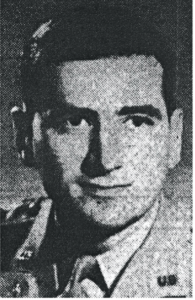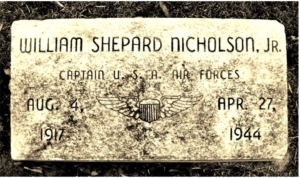Scroll of Honor – William Shepard Nicholson, Jr.
Ferry Flight
Written by: Kelly Durham
It was said to be the largest factory under one roof anywhere in the world. Its main  structure enclosed three and a half million square feet. Its assembly line was more than a mile long. By 1944, at the peak of its production, Ford Motor Company’s Willow Run assembly plant was turning out one B-24 J Liberator heavy bomber every sixty-three seconds—and they all had to go somewhere. The 5th Ferry Group of the Air Transport Command was tasked with dispatching aircraft from manufacturing plants to domestic and international airbases. One of its pilots was Captain William Shepard Nicholson, Jr. of Union.
structure enclosed three and a half million square feet. Its assembly line was more than a mile long. By 1944, at the peak of its production, Ford Motor Company’s Willow Run assembly plant was turning out one B-24 J Liberator heavy bomber every sixty-three seconds—and they all had to go somewhere. The 5th Ferry Group of the Air Transport Command was tasked with dispatching aircraft from manufacturing plants to domestic and international airbases. One of its pilots was Captain William Shepard Nicholson, Jr. of Union.
Billy Nicholson already had one degree when he enrolled at Clemson College. He earned a Bachelor of Science degree from Davidson College in 1938 and added a Clemson degree in textile science in 1940.
Following graduation, Nicholson was employed by Deering Miliken, the South Carolina-based operator of textile mills. Nicholson was called to active duty in 1942 and was sent to Fort McClellan, Alabama. From there, he trained at Camp Forrest, Tennessee and then Kelley Field, Texas where he earned his pilot’s wings in January 1943.
Nicholson was assigned to the 5th Ferry Group operating out of Love Field in Dallas, Texas. Its primary mission was to pick up new aircraft from the many factories scattered all over the country and deliver them to domestic stations and fighting fronts. To accomplish this mission, the group’s pilots and crews had to qualify to fly “anything, anywhere, anytime.” Likely their most common aircraft ferry mission was the B-24 bomber. With nearly 18,500 aircraft built, the B-24 was the most produced heavy bomber in history. Ford manufactured nearly seven thousand of the big bombers at Willow Run.
On April 27, 1944, then serving as the director of training for the 5th Ferry Group, Captain Nicholson picked up a B-24 J Liberator at Romulus, Michigan, site of one of the airports serving the Willow Run plant. His intended delivery destination was Charleston, South Carolina. Flying with a civilian copilot and an Army Air Force flight engineer, the Liberator encountered poor weather en route. In heavy rain and low clouds, the aircraft crashed into a wooded hillside and exploded near Lillington, North Carolina, just north of Fort Bragg. All three aboard were killed.
Captain Nicholson was survived by his wife, the former Sara Johnson of Asheville, North Carolina, their daughter, his parents and two sisters. He was buried in the Grove Hill Cemetery in Darlington.
For more information on William Shepard  Nicholson, Jr. see:
Nicholson, Jr. see:
https://soh.alumni.clemson.edu/scroll/william-shepard-nicholson-jr/
For additional information about Clemson University’s Scroll of Honor visit:

